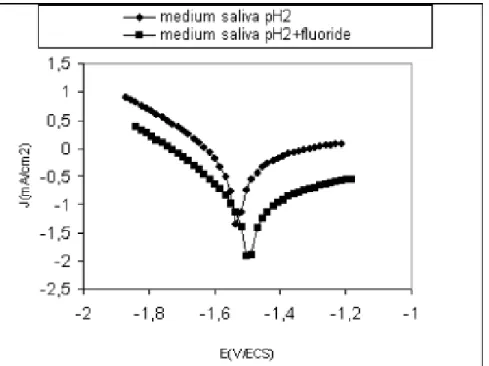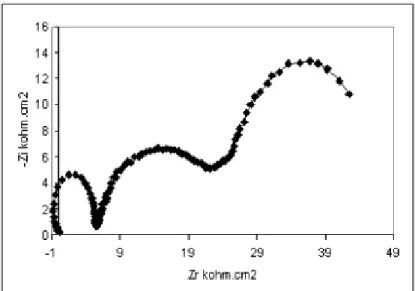Corrosion Inhibition of Titanium in Artificial Saliva Containing Fluoride
Latifa KINANI, Rachida NAJIHand Abdelilah CHTAINI*
Molecular Electrochemistry and Inorganic Materials Team, Faculty of Sciences and Technology, Beni Mellal, Morocco
*
Corresponding authors: chtainia@yahoo.fr
Abstract
The objective of this study was to demonstrate the effect of eugenol on the
titanium corrosion in artificial saliva enriched with eugenol at different
concentration. The corrosion behaviour and titanium surface characterization
were investigated by electrochemical measurements and SEM.
Keywords
Corrosion; Titanium; Fluoride; pH; Eugenol; SEM.
Introduction
Titanium and its alloys are widely used in dentistry as prosthetic appliances because of
a high corrosion resistance and good biocompatibility. These valuable properties are caused
by passive films that are rapidly formed in the body fluid environment [1-3]. Recently,
mouth-rinses, toothpastes, and prophylactic agents containing fluoride are utilizing to prevent
the dental caries. However, decreasing the corrosion resistance of titanium in solutions
containing fluoride has been reported [4-12]. The corrosion behaviours are related to the
concentration of fluoride and the surrounding environment Therefore, the surface reaction on
titanium under the existence of fluoride is important to understand the corrosion and tarnish of
titanium in oral environment. Recently the corrosion of titanium was suppressed in solutions
OH
OCH3
Figure 1. Chemical formula of eugenol
Eugenol occurs widely as a component of essential oils and is a major constituent of
clove oil. It has been used since at least the nineteenth century, primarily as a flavouring
agent, in a variety of foods and pharmaceutical products, and as an analgesic in dental
materials. Recently it has been used as inhibitor on the corrosion of stainless steel in
phosphoric acid solution [13].
Materials and Methods
The specimens used were plats (1cm x 1cm x 1mm) placed in different medium,
adaptable to the working electrode. The samples were mechanically cleaned with abrasive
strips. The electrolyte reference used was Fusayama Meyer artificial saliva. The composition
of thissolution, which closely resembles natural saliva, is KCl (0.4 g/l), NaCl (0.4 g/l), CaCl2.
2H2O (0.906 g/l), NaH2PO4. 2H2O (0.690 g/l), Na2S. 9H2O (0.005 g/l), Urea (1 g/l). The pH
was measured with an XC type glass electrode. The pH (7.03) of this reference saliva
corresponding to our first test medium. The second medium used had the same contents as the
first, but the pH was lowered by adding lactic acid. This acid was chosen in order to obtain
conditions that were as close as possible to the clinical reality. The third medium was
identical to the reference medium but was enriched with fluoride ions with a concentration of
0.1% and the last medium is containing fluoride at pH 2 at different concentration of eugenol.
For electrochemical step, we used a glass electrochemical cell, with the thermostat set at 37 ±
0.1°C. The three electrodes system was used, with a saturated calomel electrode, platinum
plat (1cm x 1cm) counter electrode and working electrode (specimens test) connected to a
impedance in different media. The surfaces of the specimens were observed on scanning
electron microscopy.
Statistical analyses
The corrosion parameters, including Icorr and Rp, were statistically analyzed using one -
way ANOVA for analyzing the factor of NaF or eugenol concentration in 0.1% NaF
containing medium. The test of Tukey’s test (α = 0.05) was chosen as the following multiple
comparison technique when necessary.
The results of two-way ANOVA for Rp values and Icorr proved that fluoride, and the
concentration of the eugenol in presence of fluoride had a statistically significant influence on
the value of Rp(p < 0.00002) and I corr (p < 2.109010-8).
Results and Discussion
The electrochemical parameters determined from the polarization curves (figure 2) are
given in Table.1. The corrosion current density of titanium grade2 increase with increasing of
pH, from 0.013 mA/cm2 in reference medium to 0,445 mA/cm2 in pH 2 medium and 2.013
mA/cm2in medium saliva pH 2 containing fluoride.
Table1. Summary of electrochemical parameters for titanium grade 2 in different media
Electrolyte Icorr(mA/cm2) Rp(Ω·cm2) E(I=0)mV
Medium saliva pH=7.03 0.013 5220 -795.3
Medium saliva pH=2 0.445 207.26 -1488
Medium saliva pH=2+fluoride 2.013 66..5 -1520
Our results have shown that fluoride ions could cause the breakdown of the protective
passivation layer, so it’s necessary to church inhibitory that suppressed this corrosion.
The electrochemical parameters determined from the polarization curves(Figure3) are
Figure 2. Polarization curves after 2h of immersion in medium saliva pH 2 with and without fluoride
Table 2. Summary of electrochemical parameters for titanium grade 2 in fluoride medium at
different Concentration of eugenol
Concentration of eugenol I corr (mA/cm2) Rp(ohm.cm2) E(I=0) E%
0 2.013 66.5
10-5 M 0.538 164.03 -1422.5 73.273
10-3 M 0.167 434.16 -1501.9 91.703
10-1 M 0.059 1610 -1062.6 97.069
The corrosion current density of titanium grade2 decrease with increasing
concentration of eugenol, from 2,013 mA/cm2 in reference medium at pH2 containing
fluoride (0,1%) to 0,059 mA/cm2 in 10-1M concentration of eugenol medium. The results
showed that eugenol revealed a good corrosion inhibitor. The inhibition efficiency depends
the concentrations of eugenol.
An impedance spectroscopy study was performed in order to confirm the results
Figure3. Polarization curves after 2h of immersion in fluoride medium saliva pH2 with and without eugenol
Figure 4 show the impedance diagrams recorded for titanium grade 2 in different
medium to examine the concentration of eugenol effect. In case fluoride medium at pH2 the
impedance curve is in the form of a half-circle which can be attributed to electron transfer
step. The diameter of circle increased with increasing the concentration of eugenol. However,
at concentration10-1M of eugenol (Figure 5) the diagrams curve is in the form of three-circle
corresponding the formation the tridimentionel film on the surface that suppressed corrosion.
Figure 5. Electrochemical impedance spectroscopy for titanium grade 2 fluoride media at pH2 + (10-1M) eugenol
The SEM micrographs (Figure 6) of titanium grade 2 after electrochemical analyses
confirmed the electrochemical results They show a general change in the surface of pure
titanium in Fusayama Meyer saliva medium, in the much more aggressive
fluoridated-acidified saliva medium the metal is characterized by localized pitting. However, the addition
of eugenol in fluoride medium at pH2 led the formation of film on the surface which increases
the metal resistance.
a) b)
Behaviour of titanium in a solution containing fluoride and eugenol were studied
electrochemical properties, surface analyses by SEM and pH. These results are summarized as
following:
1. The corrosion resistance of titanium specimens solution containing. Fluoride decreased in
comparison with that in a solution not containing fluoride. Adding eugenol to the solution
resulted in preventing the corrosion of the titanium from the fluoride.
2. The rate corrosion of titanium in acidic medium saliva (pH2) was clearly lower than that
in the solution containing fluoride atpH2.
From these results, the effects of eugenol are not only the protection of titanium from
fluoride attack but also the suppression of dissolution of titanium ions via formation of the
eugenol films. These effects evidently suppress the corrosion of titanium by fluoride.
References
1. Hanawa T., Ota M., Characterization of surface .lm formed on titanium in electrolyte
usingXPS, Appl Surf Sci, 1992, 55, p. 269-276.
2. Ong J. L., Lucas L. C., Raikar G.N., Connatser R., Gregory J. C., Spectroscopic
characterization of passivated titanium in a physiologic solution, J Mater Sci Mater Med,
1995, 6, p. 1131-119.
3. Hanawa T., Asami K., Asaoka K., Repassivation of titanium and surface oxide .lm
regenerated in simulated bioliquid, J Biomed Mater Res, 1998, 40, p. 530-538.
4. Lausmaa J., Kasemo B., Hansson S., Accelerated oxide grown on titanium implants
duringautoclavin g caused by uorine contamination, Biomaterials, 1985, 6, p. 23-27.
5. Wilhelmsen W., Grande A. P., The in.uence of hydro.uoric acid and .uoride ion on the
corrosion and passive behavior of titanium, Electrochim Acta, 1987, 32(10), p.
1469-1472.
6. Boere G., Influence of .uoride on titanium in an acidic environment measured by
7. Oda Y., Kawada E., Yoshinari M., Hasegawa K., Okabe T., The in.uence of .uoride
concentration on the corrosion of titanium and titanium alloys, Jpn J Dent Mater, 1996,
15, p. 317-322.
8. Reclaru L., Meyer J.-M., Effects of fluorides on titanium and other dental alloys in
dentistry, Biomaterials 1998, 19, p. 85-92.
9. Nakagawa M., Matsuya S., Shiraishi T., Ohta M., Effect of .fluoride concentration and pH
on corrosion behavior of titanium for dental use, J Dent Res, 1999, 78(9), p. 1568-1572.
10.Nakagawa M., Matsuya S., Udoh K., Corrosion behavior of pure titanium and titanium
alloys in .uoride-containingsolutions, Dent Mater J, 2001, 20(4), p. 305-314.
11.Nakagawa M., Matsuya S., Udoh K., Effect of fluoride and dissolved oxygen
concentrations on the corrosion behaviour of pure titanium and titanium alloys, Dent
Mater J, 2002, 21(2), p. 83-92.
12.Schiff N., Grosgogeat B., Lissac M., Dalard F., Influence of fluoride content and pH on


